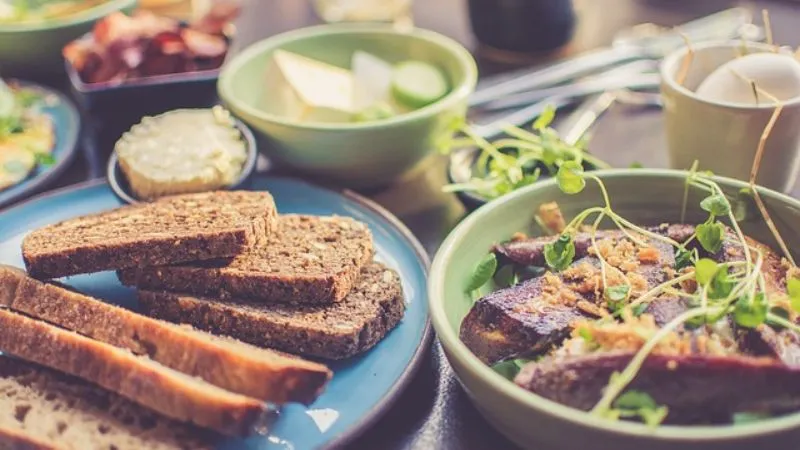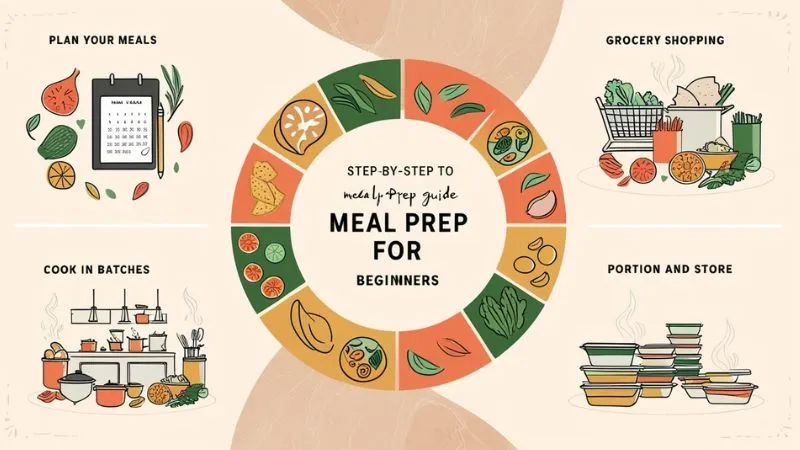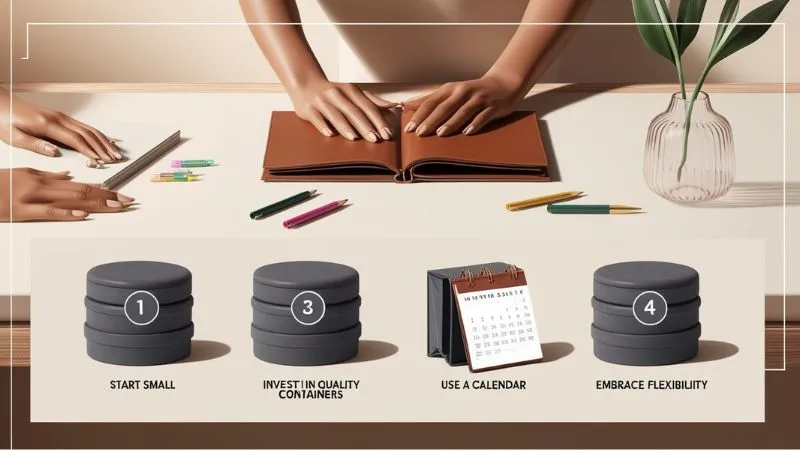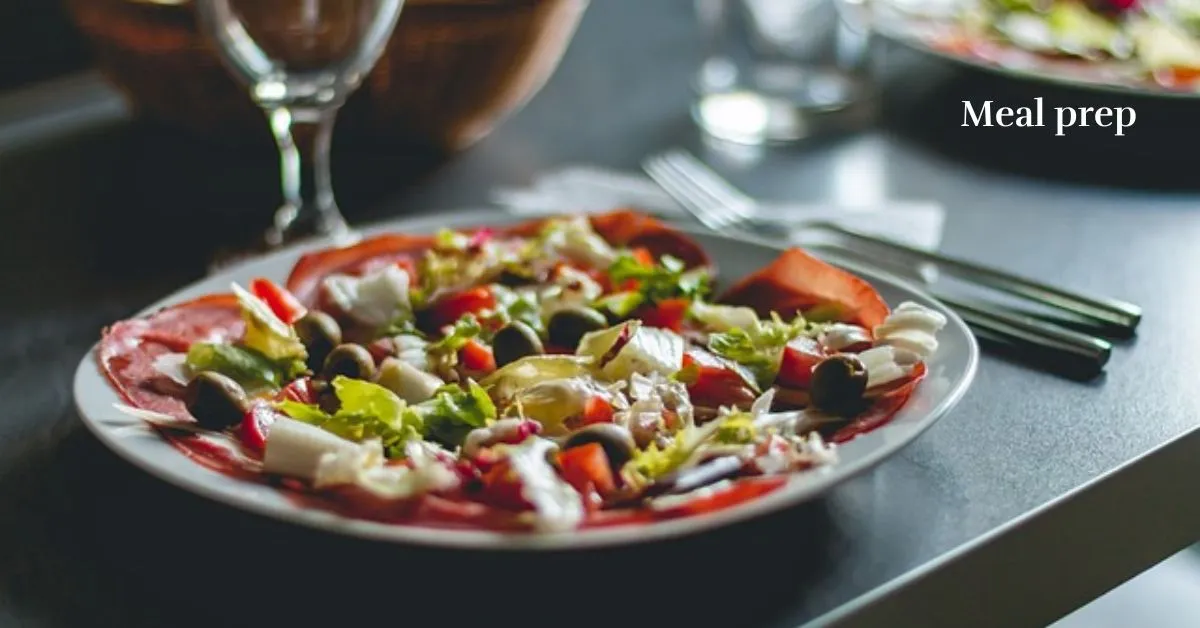Meal prep for beginners can appear daunting initially, but it’s a game-changer for saving time and cash and ensuring healthier consuming habits. Whether juggling a busy timetable or simply looking to streamline your weekly food, meal prepping gives a realistic solution. In this manual, we’ll dive into actionable steps, backed via case research and actual-existence examples, to help you get started and stay with it.

Why Meal Prep Matters
Meal prepping is greater than just cooking in bulk. It’s a scientific technique for making plans, making ready, and storing food to lessen each day’s strain and make more healthy picks more convenient. A 2021 examination published in Nutritional Science & Practice revealed that those who meal prep devour 20% fewer calories from processed foods than those who cook on the fly. This easy method can improve your food plan while liberating up treasured time during the week.
The Building Blocks of Meal Prep
Understand Your Goals
Before you start, it’s crucial to identify why you want to meal prep. Are you looking to:
- Save money by avoiding takeout?
- Eat healthier meals?
- Manage portion sizes?
- Reduce cooking time during the week?
For instance, Sarah, a working mom of two, found that meal-prepping saved her $100 a month on groceries. By preparing meals in advance, she avoided last-minute fast-food runs and provided balanced meals for her family.
Stock Your Kitchen
A nicely-stocked kitchen is the spine of meal prep. Essential tools consist of:
- Storage Containers: Opt for glass or BPA-loose plastic packing containers with stable lids.
- Measuring Tools: Invest in a digital scale and measuring cups for precise portioning.
- Cooking Appliances: A slow cooker, Instant Pot, or air fryer can make batch cooking less difficult.
- Basic Utensils: Sharp knives, a cutting board, and mixing bowls are non-negotiable.
Case in factor: Mark, a university pupil, invested in an Instant Pot and observed it reduce his meal prep time in half at the same time as permitting him to test with diverse recipes.
Read more: Teen Healthy Recipes and Meal Prep
Step-by-Step Guide to Meal Prep for Beginners

Step 1: Plan Your Meals
Start by determining which meals you want to prepare. A true rule of thumb is to recognise one or 3 meal types to avoid overwhelming yourself. For instance:
- Breakfast: Overnight oats or egg muffins
- Lunch: Grilled chicken with quinoa and vegetables
- Dinner: Stir-fried tofu with rice and steamed broccoli
Use a meal planning app or an easy spreadsheet to define your weekly meals. Include a shopping listing to preserve your preparedness.
Step 2: Grocery Shopping
Stick to your list and focus on complete foods like fruit, vegetables, lean proteins, and entire grains. Buying in bulk can also store money. For example, a 5-pound bag of brown rice is often less expensive, consistent with pounds, than smaller programs.
Step 3: Cook in Batches
Set aside 2-three hours on a delegated day to prepare dinner for your meals. Use strategies like:
- Sheet Pan Meals: Roast vegetables and proteins collectively.
- One-Pot Dishes: Soups, stews, and curries are amazing alternatives.
- Grilling: Cook several portions of fowl, fish, or tofu concurrently.
Step 4: Portion and Store
Divide your meals into personal quantities immediately after cooking. This makes it clear to grab and go in the week—label boxes with the date to make certain fresh.
Common Pitfalls and How to Avoid Them
Boredom
Eating the same meals every day can get monotonous. Rotate recipes weekly and experiment with different spices and sauces to keep things interesting.
Overcomplicating Recipes
As a starter, keep on with easy recipes with minimum ingredients. For example, a grilled fowl salad with combined greens, cherry tomatoes, and balsamic dressing is quick and easy.
Improper Storage
Not all foods store well. Avoid freezing leafy greens and eat hearty vegetables like broccoli, carrots, and bell peppers. Always use airtight containers to prevent spoilage.
Real-Life Case Study: From Chaos to Control
Meet Emma, a full-time nurse who struggled with irregular eating habits due to her hectic schedule. After committing to meal prep, Emma started preparing her meals every Sunday. Her go-to options included:
- Breakfast: Greek yogurt with granola and berries
- Lunch: Turkey wraps with hummus and veggies
- Dinner: Baked salmon with candy potatoes and asparagus
Ma reported feeling more energized within three months and saving nearly $200 monthly on food expenses.
Tips for Long-Term Success

- Start Small: Start with 1 or 2 weekly foods and step-by-step boom as you become more comfortable.
- Invest in Quality Containers: Good containers keep your food fresh and organized.
- Use a Calendar: Schedule meal prep sessions like any other appointment to ensure consistency.
- Embrace Flexibility: Life happens, and that’s okay. Keep backup meals like frozen soups or protein bars for emergencies.
Sample Meal Prep Recipes for Beginners
Recipe 1: Overnight Oats
Ingredients:
- 1/2 cup rolled oats
- 1/2 cup almond milk
- 1/4 cup Greek yogurt
- 1 tablespoon chia seeds
- 1 teaspoon honey
- Toppings: Fresh fruit, nuts, or seeds
Instructions:
- Combine oats, almond milk, yogurt, chia seeds, and honey in a jar.
- Stir well and refrigerate overnight.
- Add your favourite toppings before eating.
Recipe 2: Sheet Pan Chicken and Veggies
Ingredients:
- 2 chicken breasts
- 1 cup broccoli florets
- 1 cup diced sweet potatoes
- 2 tablespoons olive oil
- 1 teaspoon garlic powder
- Salt and pepper to taste
Instructions:
- Preheat the oven to four hundred°F (two hundred°C).
- Arrange hen and veggies on a baking sheet.
- Utilize a thin layer of olive oil and enhance the flavour with garlic powder, salt, and pepper.
- Bake for 25-half-hour or until the chicken is cooked.
The Financial Perks of Meal Prepping
According to the American Journal of Consumer Research, meal prepping can reduce grocery expenses by up to 30%. By planning, you avoid impulse purchases and minimize food waste.
For example, John, a young professional, spent $60 weekly on meal prep ingredients compared to $120 on takeout. Over a year, this saved him over $3,000.
Final Thoughts
Meal prep for beginners doesn’t have to be complicated. With clear goals, a simple plan, and the right tools, you can transform your eating habits and save time and money. Start small, stay consistent, and enjoy the benefits of a well-organized approach to meals. Your future self will thank you.
FAQs
Is it possible to achieve weight loss solely through meal preparation?
Meal prepping alone won’t make you lose weight, but it helps you control portion sizes and eat healthier. It prevents overeating and reduces reliance on junk food. Combined with exercise and staying active, it can support weight loss.
How should a beginner start a meal plan?
A beginner can start a meal plan by listing their favourite healthy foods and simple recipes. Plan meals for the week, focusing on balanced portions of protein, veggies, and carbs. Prep ingredients in advance to make cooking easy and stick to the plan.
How do I begin meal prepping?
To start meal prepping, choose a few simple recipes you like and gather the ingredients. Cook in bulk, divide the meals into containers, and store them in the fridge or freezer. Begin with prepping for 2-3 days to make it easy to stick to.
What are the best foods for meal prepping?
The best foods for meal prepping stay fresh and taste good later. Examples include cooked chicken, rice, quinoa, roasted veggies, and beans. You can also include hard-boiled eggs, salads, and fruits like berries or apples.
